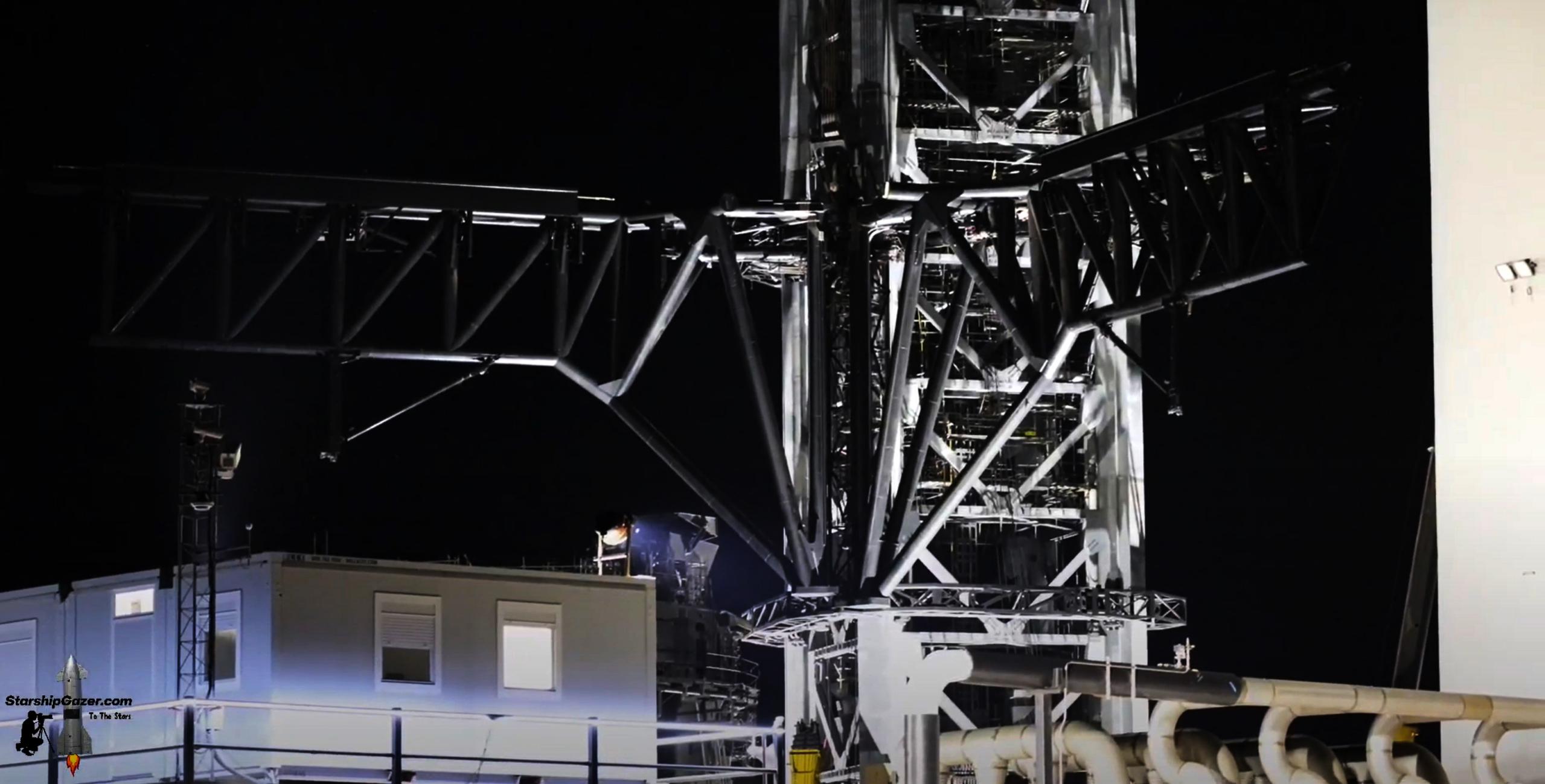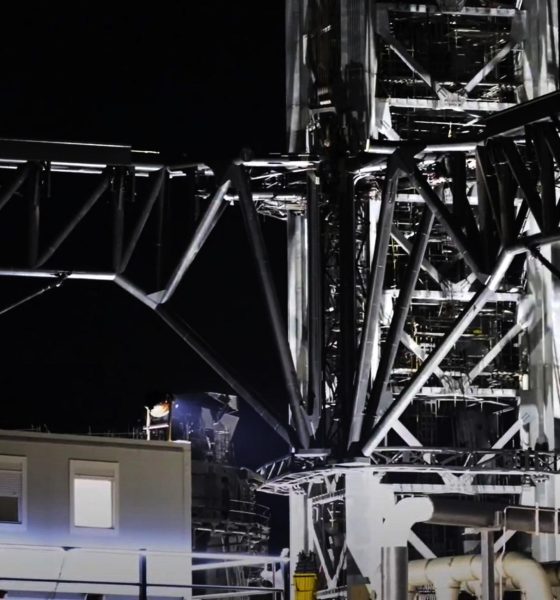Update: Shortly after publishing, SpaceX began a much more ambitious series of tests with the Starship launch tower’s two main arms, which are designed to lift and (one day) catch Starships and Super Heavy boosters.
After lifting the arm carriage about 15m (~50 ft), several times higher than January 3rd’s far more conservative kickoff, SpaceX fired up each arm’s main hydraulic actuator and opened them about as wide as they’re able to move. Unsurprisingly, the arms’ first powered lateral movement happened very slowly, obviously telegraphing caution but probably also hinting at the start of a calibration process needed to determine their full range of motion and associate those positions with certain sensor readings or telemetry to ensure they can be safely controlled. As of midnight CST, that testing has continued well into the night.
Regardless of the purpose, substantial powered movement is a major milestone for the tower’s main arms and all but guarantees that more extensive tests and simulations are soon to come.
SpaceX has moved Starbase’s rocket-catching “chopstick” arms for the first time since they were installed on the orbital Starship pad’s ‘launch tower’ two months ago.
After a shockingly brisk three-month period of assembly, the first arm installed in late August 2021 was a lone structure designed to swing in; grab and stabilize Super Heavy with its claw; fuel and power Starship; and quickly detach and swing away from the rocket during launch. A month and a half later, SpaceX begin installing a much larger pair of more complex arms in mid-October. Unlike the Starship quick-disconnect (QD) arm, the pair of arms that followed were almost nothing like anything built as part of another rocket launch complex.
Unlike other ‘arms’ related to other rocket launch facilities, the pair SpaceX began to install on Starbase’s launch tower were colossal, measuring more than 30m (100+ ft) long and 5-10m (15-30 ft) tall. Built out of heavy-duty steel pipe and affixed to an even sturdier pair of claw-like supports that grab onto the launch tower, the combined assembly likely weighs hundreds of tons. Aside from their sheer scale, Starbase’s main tower arms are also attached to a complex system of cables and an industrial-strength ‘drawworks’ commonly used on giant oil rigs and derricks.
They also feature huge actuators that allow the two arms to open and close, revealing a bit of their purpose. While the main reason they likely exist is to provide SpaceX with an all-weather alternative to cranes for lifting, manipulating, and precisely stacking Starships and Super Heavy boosters at the launch pad, the headline – ever since Musk revealed the idea – has always been plans to use those same arms to literally catch rockets out of mid-air.
To do so, they’ll need to be able to actuate and move extremely quickly and precisely up and down the Starship launch tower, matching the velocity and autonomously determining the position of landing Super Heavy boosters (and possibly Starships) to avoid major damage or the loss of entire vehicles. While arguably an unnecessary gamble and an attempt to micro-optimize the concept of operations of a rocket that’s yet to attempt a single orbital-class launch, SpaceX’s CEO is clearly committed to the idea and – whether or not the first iteration works – has fully delivered on the first complete lift-and-catch system.
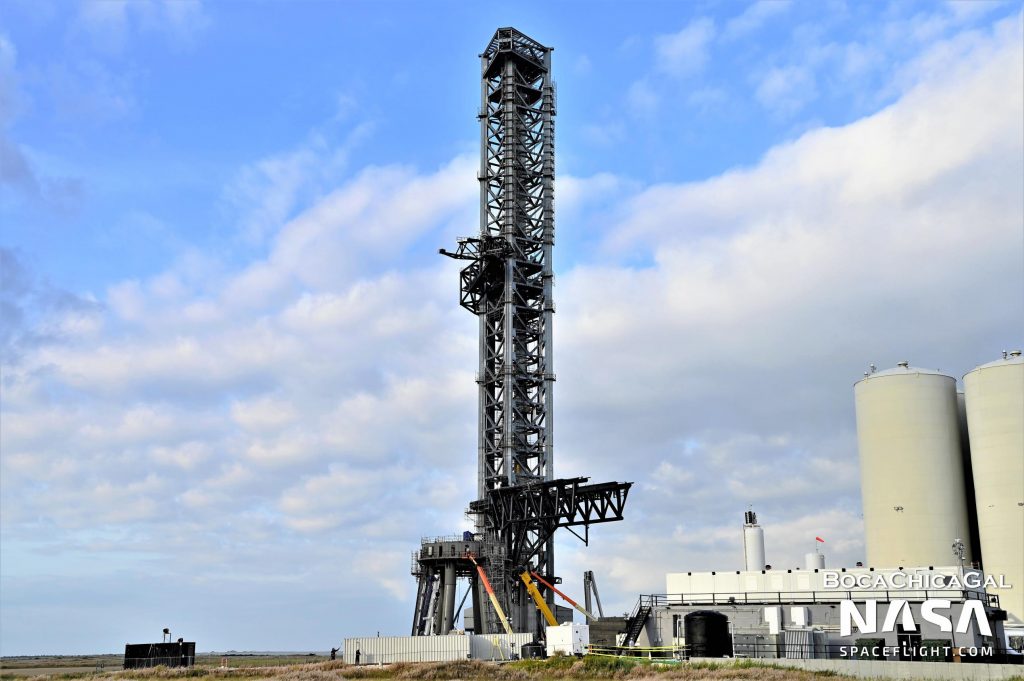
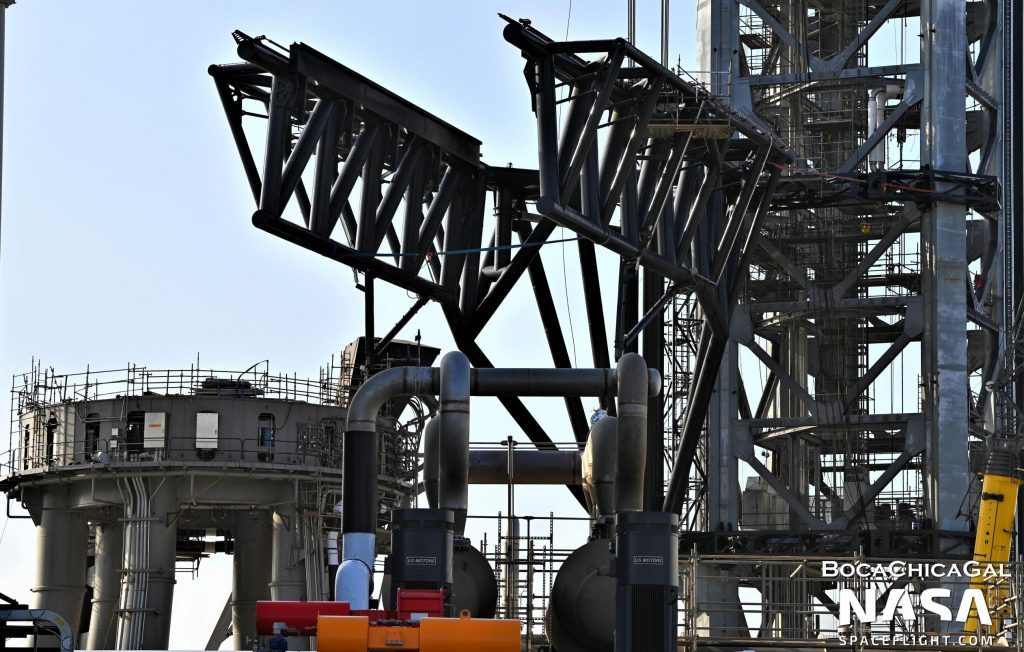
On January 3rd, 2022, after removing a large amount of scaffolding in the days prior, SpaceX briefly and slightly moved the installed arms for the first time, using the drawworks to lift the entire arm-and-carriage assembly a few meters (~6 ft) up and down the tower. Once a few minor additional steps are taken, the chopsticks could be ready for much more extensive testing, beginning with basic lift, descent, and arm actuation tests to calibrate and then proof the first-of-its-kind mechanism. Later, SpaceX will likely simulate catching rockets in a wide range of scenarios. Somewhere before, during, or after that testing, SpaceX may perform another fit test with Starship S20 and Super Heavy B4 – but this time using the arms to lift and install the stages.

Elon Musk
SpaceX issues statement on Starship V3 Booster 18 anomaly
The incident unfolded during gas-system pressure testing at the company’s Massey facility in Starbase, Texas.

SpaceX has issued an initial statement about Starship Booster 18’s anomaly early Friday. The incident unfolded during gas-system pressure testing at the company’s Massey facility in Starbase, Texas.
SpaceX’s initial comment
As per SpaceX in a post on its official account on social media platform X, Booster 18 was undergoing gas system pressure tests when the anomaly happened. Despite the nature of the incident, the company emphasized that no propellant was loaded, no engines were installed, and personnel were kept at a safe distance from the booster, resulting in zero injuries.
“Booster 18 suffered an anomaly during gas system pressure testing that we were conducting in advance of structural proof testing. No propellant was on the vehicle, and engines were not yet installed. The teams need time to investigate before we are confident of the cause. No one was injured as we maintain a safe distance for personnel during this type of testing. The site remains clear and we are working plans to safely reenter the site,” SpaceX wrote in its post on X.
Incident and aftermath
Livestream footage from LabPadre showed Booster 18’s lower half crumpling around the liquid oxygen tank area at approximately 4:04 a.m. CT. Subsequent images posted by on-site observers revealed extensive deformation across the booster’s lower structure. Needless to say, spaceflight observers have noted that Booster 18 would likely be a complete loss due to its anomaly.
Booster 18 had rolled out only a day earlier and was one of the first vehicles in the Starship V3 program. The V3 series incorporates structural reinforcements and reliability upgrades intended to prepare Starship for rapid-reuse testing and eventual tower-catch operations. Elon Musk has been optimistic about Starship V3, previously noting on X that the spacecraft might be able to complete initial missions to Mars.
Elon Musk
SpaceX Starship Version 3 booster crumples in early testing
Photos of the incident’s aftermath suggest that Booster 18 will likely be retired.
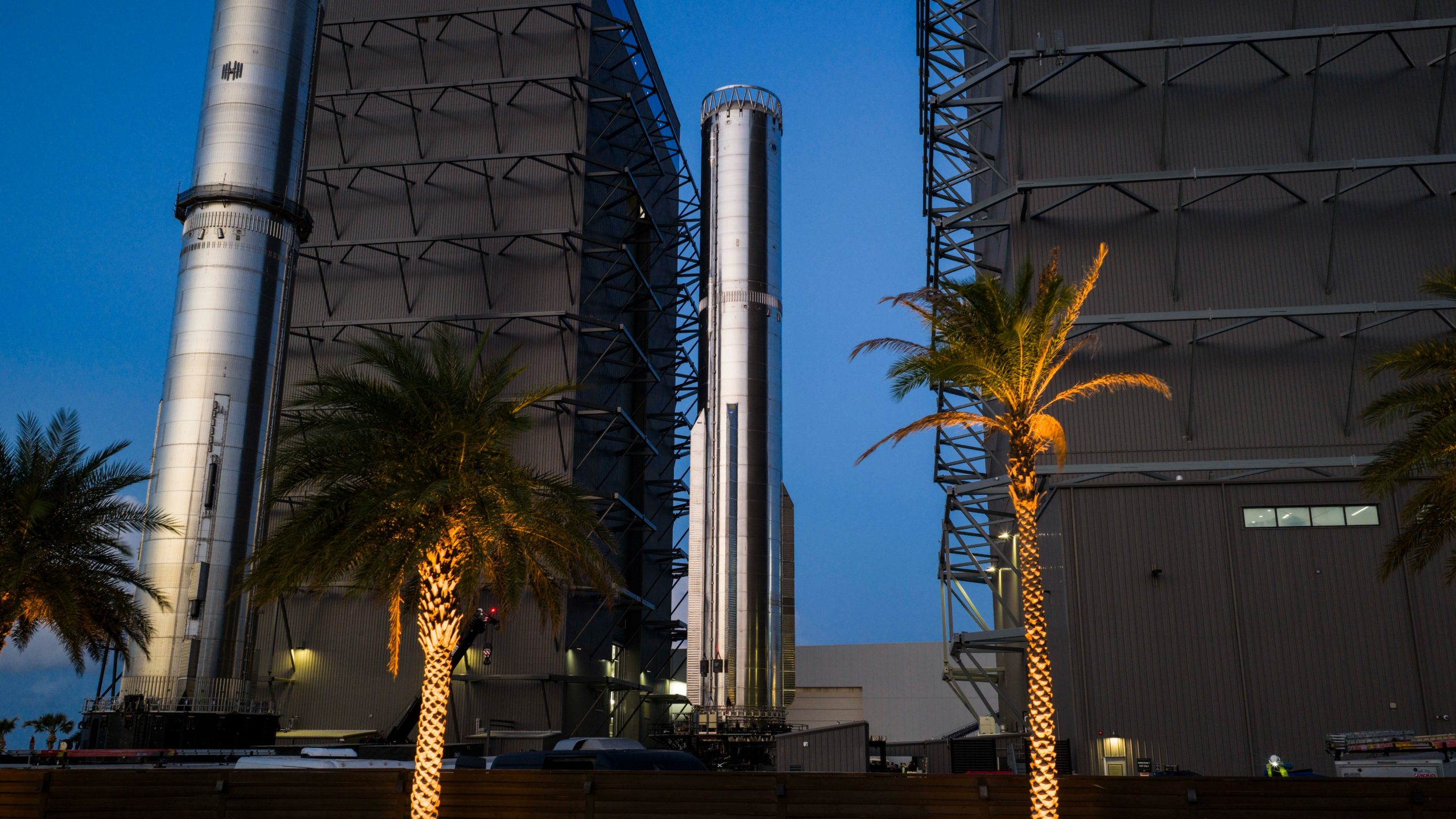
SpaceX’s new Starship first-stage booster, Booster 18, suffered major damage early Friday during its first round of testing in Starbase, Texas, just one day after rolling out of the factory.
Based on videos of the incident, the lower section of the rocket booster appeared to crumple during a pressurization test. Photos of the incident’s aftermath suggest that Booster 18 will likely be retired.
Booster test failure
SpaceX began structural and propellant-system verification tests on Booster 18 Thursday night at the Massey’s Test Site, only a few miles from Starbase’s production facilities, as noted in an Ars Technica report. At 4:04 a.m. CT on Friday, a livestream from LabPadre Space captured the booster’s lower half experiencing a sudden destructive event around its liquid oxygen tank section. Post-incident images, shared on X by @StarshipGazer, showed notable deformation in the booster’s lower structure.
Neither SpaceX nor Elon Musk had commented as of Friday morning, but the vehicle’s condition suggests it is likely a complete loss. This is quite unfortunate, as Booster 18 is already part of the Starship V3 program, which includes design fixes and upgrades intended to improve reliability. While SpaceX maintains a rather rapid Starship production line in Starbase, Booster 18 was generally expected to validate the improvements implemented in the V3 program.
Tight deadlines
SpaceX needs Starship boosters and upper stages to begin demonstrating rapid reuse, tower catches, and early operational Starlink missions over the next two years. More critically, NASA’s Artemis program depends on an on-orbit refueling test in the second half of 2026, a requirement for the vehicle’s expected crewed lunar landing around 2028.
While SpaceX is known for diagnosing failures quickly and returning to testing at unmatched speed, losing the newest-generation booster at the very start of its campaign highlights the immense challenge involved in scaling Starship into a reliable, high-cadence launch system. SpaceX, however, is known for getting things done quickly, so it would not be a surprise if the company manages to figure out what happened to Booster 18 in the near future.
Elon Musk
SpaceX’s next project will produce Starships at a level that sounds impossible
1,000 rockets per year is an insane number, especially considering Starship’s sheer size.
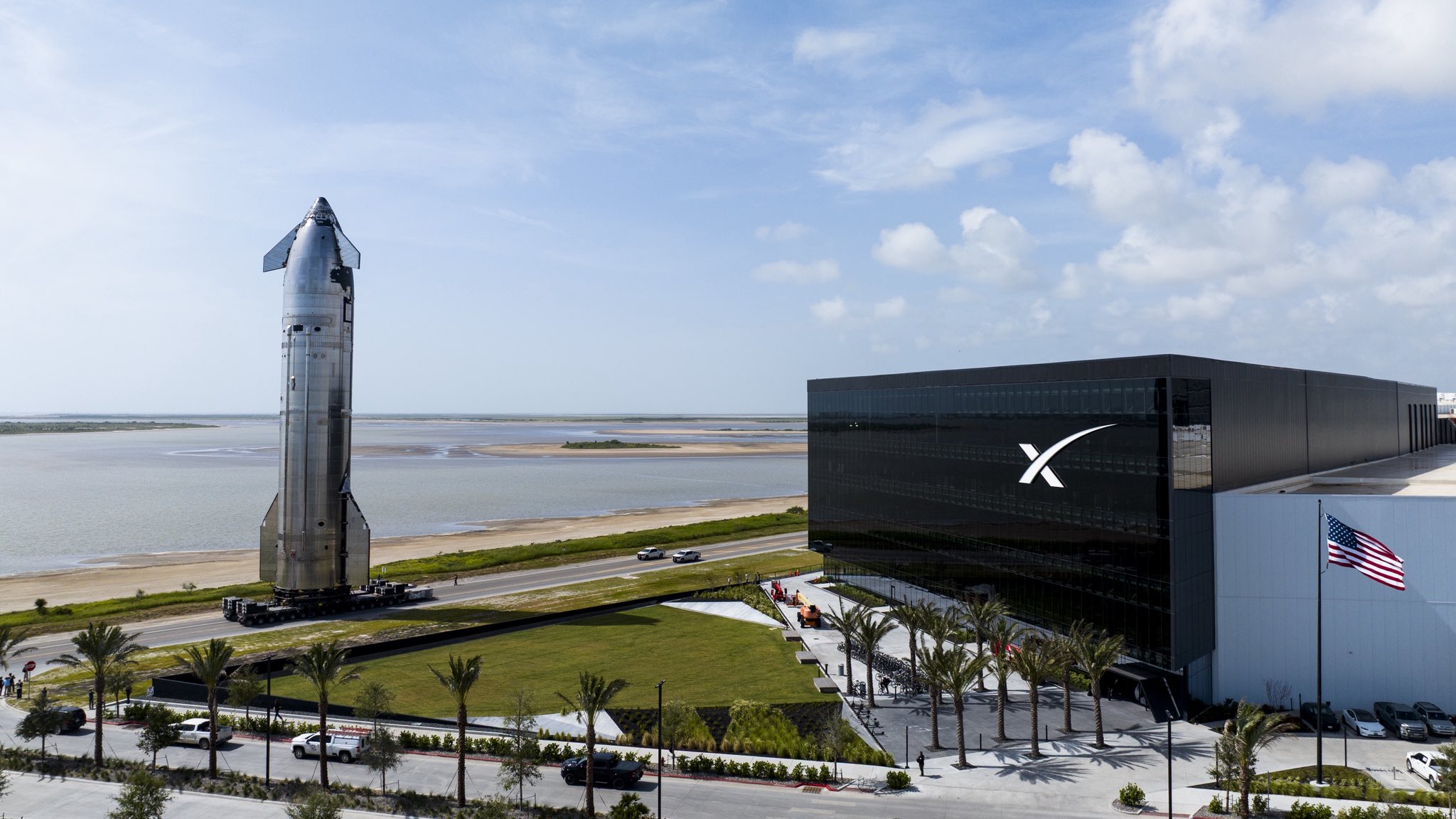
Elon Musk has revealed bold plans for SpaceX’s newest Starbase facility in Texas, predicting it will become a birthplace for “so many spaceships.” The upcoming “Gigabay,” a massive $250 million production hub in Starbase, Texas, is designed to manufacture up to 1,000 Starship rockets per year.
That’s an insane number of rockets for a single facility, especially considering Starship’s sheer size.
One of the world’s largest industrial structures
SpaceX’s Gigabay is expected to stand roughly 380 feet tall and enclose 46.5 million cubic feet of interior space, making it one of the largest industrial structures to date. The facility will feature 24 dedicated work cells for assembling and refurbishing Starship and Super Heavy vehicles, complete with heavy-duty cranes capable of lifting up to 400 U.S. tons, as noted in a Times of India report.
Construction crews have already placed four tower cranes on-site, with completion targeted for December 2026. Once operational, the Gigabay is expected to boost SpaceX’s launch cadence dramatically, as it would be able to build up to 1,000 reusable Starships per year, as noted in a report from the Dallas Express. Musk stated that the Gigabay will be “one of the biggest structures in the world” and hinted that it represents a major leap in Starbase’s evolution from test site to full-scale production hub.
A key step toward Mars and beyond
Starship is SpaceX’s heavy-lift rocket system, and it remains a key part of Elon Musk’s vision of a multiplanetary future. The vehicle can carry 100–150 tonnes to low Earth orbit and up to 250 tonnes in expendable mode. With several successful flights to date, including a perfect 11th test flight, the Starship program continues to refine its reusable launch system ahead of crewed lunar missions under NASA’s Artemis initiative.
Starship is unlike any other spacecraft that has been produced in the past. As per Elon Musk, Starship is a “planet-colonizer” class rocket, as the magnitude of such a task “makes other space transport task trivial.” Considering Starship’s capabilities, it could indeed become the spacecraft that makes a Moon or Mars base feasible.
